千奕西班牙语入门语法:直接引语和间接引语
直接引语与间接引语的讲解及练习
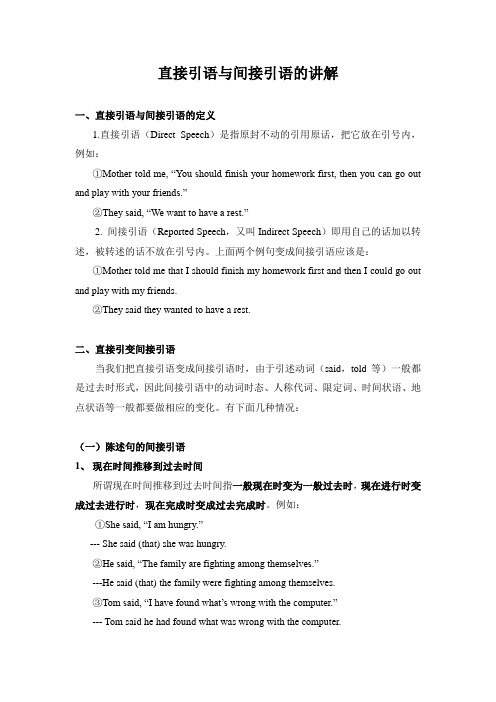
直接引语与间接引语的讲解一、直接引语与间接引语的定义1.直接引语(Direct Speech)是指原封不动的引用原话,把它放在引号内,例如:①Mother told me, “You should finish your homework first, then you can go out and play with your friends.”②They said, “We want to have a rest.”2. 间接引语(Reported Speech,又叫Indirect Speech)即用自己的话加以转述,被转述的话不放在引号内。
上面两个例句变成间接引语应该是:①Mother told me that I should finish my homework first and then I could go out and play with my friends.②They said they wanted to have a rest.二、直接引变间接引语当我们把直接引语变成间接引语时,由于引述动词(said,told等)一般都是过去时形式,因此间接引语中的动词时态、人称代词、限定词、时间状语、地点状语等一般都要做相应的变化。
有下面几种情况:(一)陈述句的间接引语1、现在时间推移到过去时间所谓现在时间推移到过去时间指一般现在时变为一般过去时,现在进行时变成过去进行时,现在完成时变成过去完成时。
例如:①She said, “I am hungry.”--- She said (that) she was hungry.②He said, “The family are fighting among themselves.”---He said (that) the family were fighting among themselves.③Tom said, “I have found what’s wrong with the computer.”--- Tom said he had found what was wrong with the computer.◆在下列场合,尽管陈述动词为过去时形式,间接引语中的动词时态却不必改变,即:a)当引述的是客观事实、科学真理、现在习惯工作以及格言等内容时:①He said, “The earth goes around the sun .”--- He said that the earth goes around the sun.b)当动词所表示的状态或动作在引述时仍在继续时:“I’m forty,” he said.--- He said he is forty.c)当直接引语中有情态动词should, would, could, had better, would rather, might, must, ought to时He said, “It must be pretty late. I really must go.”---He said it must be pretty late, and he really must go.He said, “You mustn’t smoke in the room.”--- He said I mustn’t smoke in the room.2、过去时间推移到过去的过去这里需要注意以下几点:a)当强调动作或状态先于引述动词时,一般过去时要变成过去完成时。
直接引语和间接引语讲解

5)当直接引语中有情态动词should, would, could, had better, would rather, might, must, ought to, used to, need时, 例如: The doctor said, “You'd better drink plenty of water.” —> The doctor said I'd better drink plenty of water. He said, “She must be a teacher.” —> He said that she must be a teacher.
4、时间状语、地点状语及某些对比性的指示代词 和动词变化 1)时间状语:
直接引语ay next week
then the next(following)day that day the next(following)week (month, year) yesterday the day before two days ago two days before last week (month, year) the week(month, year) before this week that week(month, year)
→He said that practice makes perfect.
8)此外转述中的变化要因实际情况而 定,不能机械照搬,如果当地转述, here不必改为there, 动词come不必改为 go,如果当天转述yesterday, tomorrow, this afternoon等均不必改变。如: Teacher: You may have the ball game this afternoon. Student : What did the teacher say, Monitor? Monitor: He said we might have the ball game this afternoon.
直接引语与间接引语
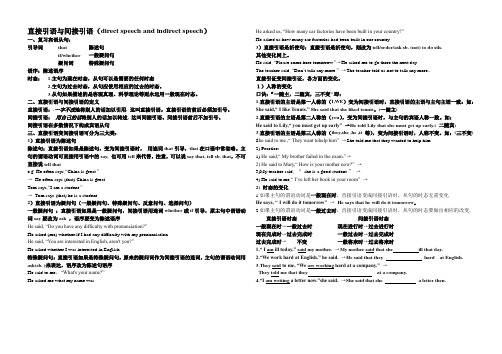
直接引语与间接引语(direct speech and indirect speech)一、复习宾语从句:引导词that 陈述句if/whether 一般疑问句疑问词特殊疑问句语序:陈述语序时态: 1.主句为现在时态,从句可以是需要的任何时态2.主句为过去时态,从句应使用相应的过去的时态。
3.从句如果描述的是客观真理、科学理论等则永远用一般现在时态。
二、直接引语与间接引语的定义直接引语:.一字不改地将别人的话加以引用, 这叫直接引语。
直接引语的前后必须加引号。
间接引语:用自己的话将别人的话加以转述, 这叫间接引语。
间接引语前后不加引号。
间接引语在多数情况下构成宾语从句三、直接引语变间接引语可分为三大类:1)直接引语为陈述句陈述句:直接引语如果是陈述句,变为间接引语时,用连词that引导,that在口语中常省略。
主句的谓语动词可直接用引语中的say, 也可用tell来代替,注意,可以说say that, tell sb. that,不可直接说tell thate.g. He often says,“China is great.”→He often says (that) China is great.Tom says,“I am a student.”→Tom says (that) he is a student.2)直接引语为疑问句(一般疑问句、特殊疑问句、反意问句、选择问句)一般疑问句:直接引语如果是一般疑问句,间接引语用连词whether或if引导,原主句中谓语动词say要改为ask ,语序要变为陈述语序He said, “Do you have any difficulty with pronunciation?”He asked (me) whether/if I had any difficulty with my pronunciation.He said, “You are interested in English, aren't you?”He asked whether I was interested in English.特殊疑问句:直接引语如果是特殊疑问句,原来的疑问词作为间接引语的连词,主句的谓语动词用ask(sb. )来表达,语序改为陈述句语序He said to me,“What's your name?”He asked me what my name was. He asked us, “How many car factories have been built in your country?”He asked us how many car factories had been built in our country.3)直接引语是祈使句:直接引语是祈使句,则改为tell/order/ask sb. (not) to do sth.其他变化同上。
西班牙语语法总结超全(新)
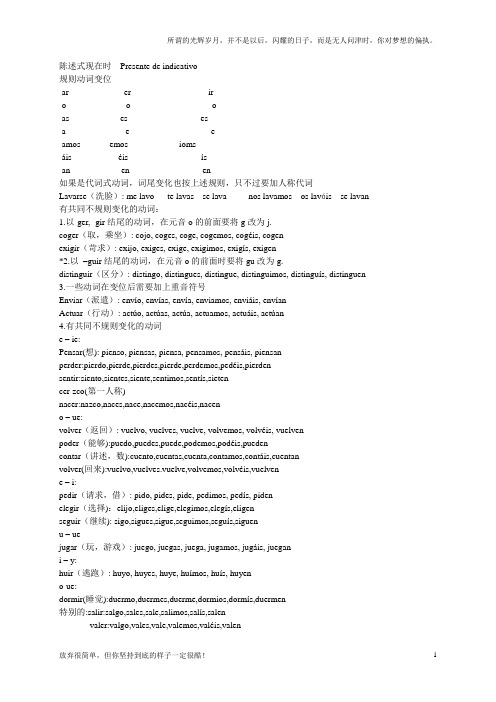
陈述式现在时Presente de indicativo规则动词变位-ar -er -ir-o -o -o-as -es -es-a -e -e-amos -emos -ioms-áis -éis -ís-an -en -en如果是代词式动词,词尾变化也按上述规则,只不过要加人称代词Lavarse(洗脸): me lavo te lavas se lava nos lavamos os laváis se lavan 有共同不规则变化的动词:1.以-ger, -gir结尾的动词,在元音o的前面要将g改为j.coger(取,乘坐): cojo, coges, coge, cogemos, cogéis, cogenexigir(苛求): exijo, exiges, exige, exigimos, exigís, exigen*2.以–guir结尾的动词,在元音o的前面时要将gu改为g.distinguir(区分): distingo, distingues, distingue, distinguimos, distinguís, distinguen 3.一些动词在变位后需要加上重音符号Enviar(派遣): envío, envías, envía, enviamos, enviáis, envíanActuar(行动): actúo, actúas, actúa, actuamos, actuáis, actúan4.有共同不规则变化的动词e – ie:Pensar(想): pienso, piensas, piensa, pensamos, pensáis, piensanperder:pierdo,pierde,pierdes,pierde,perdemos,pedéis,pierdensentir:siento,sientes,siente,sentimos,sentís,sietencer-zco(第一人称)nacer:nazco,naces,nace,nacemos,nacéis,naceno – ue:volver(返回): vuelvo, vuelves, vuelve, volvemos, volvéis, vuelvenpoder(能够):puedo,puedes,puede,podemos,podéis,puedencontar(讲述,数):cuento,cuentas,cuenta,contamos,contáis,cuentanvolver(回来):vuelvo,vuelves.vuelve,volvemos,volvéis,vuelvene – i:pedir(请求,借): pido, pides, pide, pedimos, pedís, pidenelegir(选择):elijo,eliges,elige,elegimos,elegís,eligenseguir(继续): sigo,sigues,sigue,seguimos,seguís,siguenu – uejugar(玩,游戏): juego, juegas, juega, jugamos, jugáis, juegani – y:huir(逃跑): huyo, huyes, huye, huímos, huís, huyeno-ue:dormir(睡觉):duermo,duermes,duerme,dormios,dormís,duermen特别的:salir:salgo,sales,sale,salimos,salís,salenvaler:valgo,vales,vale,valemos,valéis,valenreír:río,ríes,ríe,reímos,reís,ríen部分完全不规则动词的变位:ser:soy, eres, es, somos, sois, sonestar:estoy, estás, está, estamos, estáis, estánhacer:hago, haces, hace, hacemos, hacéis, hacenir:voy, vas, va, vamos, vais, vandar: doy,das,da,damos,dáis,danver:veo, ves, ve, vemos, veis, venhaber:he, has, ha, ha, hemos, habéis, hantener:tengo, tienes, tiene, tenemos, tenéis, tienenvenir:vengo, vienes, viene, venimos, venís, vienenquerer: quiero, quieres, quiere, queremos, queréis, quierenoir: oigo, oyes, oye, oímos, oís, oyenponer: pongo, pones, pone, ponemos, ponéis, ponensaber: sé, sabes, sabe, sabemos, sabéis, sabentraer: traigo, traes, trae, traemos, traéis, traencaber(容纳): quepo,cabes,cabe,cabemos,cabéis,cabenasir(抓住):asgo,ases,ase,asimos,asís,asencaer(落下): caigo,caes.cae.caemos,caéis,caen陈述式现在时的用法1. 表示说话时正在进行的动作Veo un árbol.2.表示经常性和习惯性的动作Pedro escribe por la mañana.3.表示现在的特征和状态Tengo quince años.4.表示客观事实或普遍真理La Tierra gira alrededor del sol. 地球绕着太阳转。
千奕西班牙语零基础入门语法

千奕西班牙语零基础入门语法Gramática 语法一、指示形容词与指示代词1.este、ese和aquel与名词连用时,称为指示形容词。
其中este指离说话者较近的人或物,ese指离听者较近的人或物,而aquel通常指离说话者和听者较远的人或物。
2.这组词有单复数和阴阳性之分:阳性单数阴性单数阴性复数阴性复数这 este esta estos estas那 ese esa esos esas那(较远) aquel aquello aquellos aquellas例如:este vaso 这个水杯esta mesa 这张桌子estos vasos 这些水杯estas mesas 这些桌子ese libro 那本书esa pluma 那支钢笔esos libros 那些书esas plumas 那些钢笔aquel muchacho 那个小伙子aquella muchacha 那个姑娘aquellos muchachos 那些小伙子aquellas muchachas 那些姑娘注:1.指示形容词后面的名词被省略时,称为指示代词。
语法规定此时要在其重读音节上加上重音符号,例如:En la mesa hay dos libros; éste es nuevo y ése es viejo.桌子上有两本书。
这本是新的,那本是旧的。
2.在西班牙也有人喜欢略去此重音符号,例如:Aquí hay dos plumas; esta es roja y esa es verde.这里有两支钢笔。
这支是红色的,那支是绿色的。
二、物主形容词(1)西班牙语物主形容词分为两组,一组称为非重读物主形容词,另一组称为重读物主形容词。
这里分别向大家介绍:1.非重读物主形容词如下:mi 我的 nuestro 我们的tu 你的 vuestro 你们的↗他的↗他们的su → 她的 su →她们的↘您的↘诸位的非重读物主形容词有两个特点:1) 不能转换成代词,在“这本书是我的”这句话里,“我的”是代词,不能用“mi”表示。
西班牙语入门语法
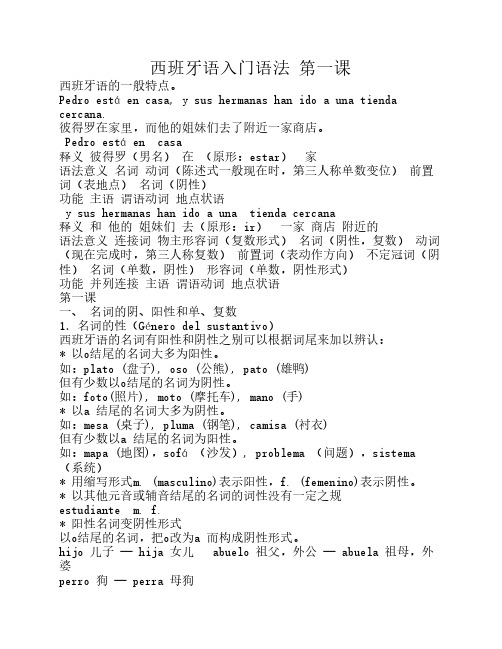
西班牙语入门语法 第一课西班牙语的一般特点。
Pedro está en casa, y sus hermanas han ido a una tienda cercana.彼得罗在家里,而他的姐妹们去了附近一家商店。
Pedro está en casa释义 彼得罗(男名) 在 (原形:estar) 家语法意义 名词 动词(陈述式一般现在时,第三人称单数变位) 前置词(表地点) 名词(阴性)功能 主语 谓语动词 地点状语y sus hermanas han ido a una tienda cercana释义 和 他的 姐妹们 去(原形:ir) 一家 商店 附近的语法意义 连接词 物主形容词(复数形式) 名词(阴性,复数) 动词(现在完成时,第三人称复数) 前置词(表动作方向) 不定冠词(阴性) 名词(单数,阴性) 形容词(单数,阴性形式)功能 并列连接 主语 谓语动词 地点状语第一课一、 名词的阴、阳性和单、复数1.名词的性(Género del sustantivo)西班牙语的名词有阳性和阴性之别可以根据词尾来加以辨认:* 以o结尾的名词大多为阳性。
如:plato (盘子), oso (公熊), pato (雄鸭)但有少数以o结尾的名词为阴性。
如:foto(照片), moto (摩托车), mano (手)* 以a 结尾的名词大多为阴性。
如:mesa (桌子), pluma (钢笔), camisa (衬衣)但有少数以a 结尾的名词为阳性。
如:mapa (地图),sofá (沙发), problema (问题),sistema (系统)* 用缩写形式m. (masculino)表示阳性,f. (femenino)表示阴性。
* 以其他元音或辅音结尾的名词的词性没有一定之规estudiante m. f.* 阳性名词变阴性形式以o结尾的名词,把o改为a 而构成阴性形式。
直接引语与间接引语的用法

直接引语与间接引语:直接引语和间接引语在句中都作宾语。
一字不漏地引述别人的话叫直接引语;用自己的话转述别人的话叫间接引语。
直接引语变为间接引语应注意以下问题:(1)间接引语的引述动词,除了常见的say,tell外,还有ask,add,admit,announce,argue,explain,insist,promise,repeat,reply,suggest,warn等表示说话的动词。
这些动词后的宾语从句常用从属连词that引导,这种连词有时可以省略。
但当引导词为who,what,which,when,where,how,why等词时,这些疑问代词和疑问副词便不能省略。
引述动词大多数可以不变,但有的必须变化,如:“What’s this? ”cried Dr. Sun.→Dr.Sun asked in surprise what that was。
时态变化的情况如果主句为过去的某种时态,则间接引语的时态应相应向前推一个时态,如下表所示:e.g.Tina said,“I usually get up at six.”→Tim said she usually got up at six.蒂娜说她通常六点起床。
(一般现在时变为一般过去时)Martin told me,“I rang Alice yesterday.”→Martin told me that he had rung Alice the day before.马丁告诉我说他昨天已经给艾丽斯打电话了。
(一般过去时变为过去完成时)Nina tol d me,“Lisa is studying abroad.”Nina told me that Lisa was studying abroad.尼娜告诉我丽莎正在国外学习。
(现在进行时变为过去进行时)Hayley said to me,“I will see you at the same place tomorrow.”→Hayley said to me that she would see me at the same place the next day.海莉对我讲她第二天要在同一地点见我。
直接引语和间接引语

直接引语与间接引语直接引语与间接引语(I)(一)直接引语(Direct Speech)在引用别人的原话时,被引用的句子称为直接引语(direct speech)。
引起引语的词称为引述动词(reporting verbs)。
“I remember I had seen you.”I said.“I rang the bell,”James said,“and your maid let me in.”“I know that.”replied Mrs. Green.(二)间接引语(Indirect Speech)当人们用自己的话报导别人的话时,被报导的部分称为间接引语(indirect speech),也可称作引语结构(report structure)。
Mary said she had already seen the film.He replied that he was going by train.这时被引用部分常常是引用动词的宾语。
除了say, reply这类词外,还有很多动词可跟这种从句。
He felt he had to do something.She guessed that he had gone to town.He thought she was worried.He explained that the train wasn't running.本模块我们主要学习的是陈述句的转换。
直接引语是陈述句时,若变成间接引语,结构上实际上是将原先的单独一个句子变成一个宾语从句。
如He said, “I can speak English.”这句话变成间接引语则是:He said that he could speak English. 原先的单独一句I can speak English 变成了that he could speak English作said的宾语了。
直接引语是陈述句变成间接引语时,存在引导从句的连接词问题。
西语语法知识点范文
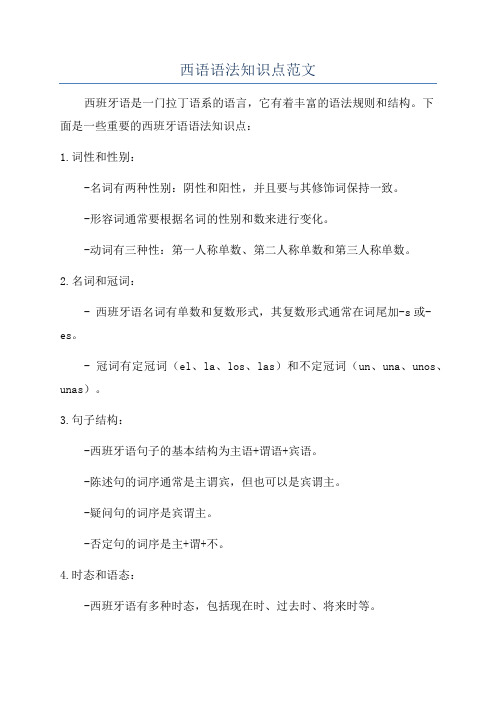
西语语法知识点范文西班牙语是一门拉丁语系的语言,它有着丰富的语法规则和结构。
下面是一些重要的西班牙语语法知识点:1.词性和性别:-名词有两种性别:阴性和阳性,并且要与其修饰词保持一致。
-形容词通常要根据名词的性别和数来进行变化。
-动词有三种性:第一人称单数、第二人称单数和第三人称单数。
2.名词和冠词:- 西班牙语名词有单数和复数形式,其复数形式通常在词尾加-s或-es。
- 冠词有定冠词(el、la、los、las)和不定冠词(un、una、unos、unas)。
3.句子结构:-西班牙语句子的基本结构为主语+谓语+宾语。
-陈述句的词序通常是主谓宾,但也可以是宾谓主。
-疑问句的词序是宾谓主。
-否定句的词序是主+谓+不。
4.时态和语态:-西班牙语有多种时态,包括现在时、过去时、将来时等。
-西班牙语中的动词语态有主动语态和被动语态。
- 被动语态通常由助动词“ser”或“estar”加上动词的过去分词构成。
5.介词和代词:-西班牙语中的介词在句子中用来表示位置、方向、时间等概念。
-代词用来代替名词,例如人称代词、反身代词和指示代词等。
-代词有主格、宾格、所有格和反身格等形式。
6.直述和间接引语:-西班牙语中的直述引语和间接引语的用法与英语有所不同。
- 直述引语通常用引号括起来,而间接引语则使用连词“que”。
-直述引语和间接引语的动词形式和时态可能要发生变化。
7.相对从句和条件句:-相对从句用来修饰名词,并且从句中的动词形式通常要发生变化。
-条件句分为现实条件句和假设条件句,其动词形式和时态要根据具体的情况来确定。
8.陈述句的否定和疑问:- 否定句的词序是主+谓+不,例如“no quiero”(我不想要)。
- 疑问句有直接疑问句和间接疑问句,其中直接疑问句的词序为宾谓主,例如“¿dónde estás?”(你在哪里?)以上是一些重要的西班牙语语法知识点,这些知识点可以帮助学习者更好地理解和使用西班牙语。
直接引语和间接引语课件

解题步骤: “Don’t Don’t talk in class,” the teacher said to us. The teacher said said to to us not to talk in class told The teacher told us not to ta上的变化
解题步骤: 1). 陈述句变间接引语时,用that连接, that 无实际意义,可省略。例 : “I don’t like computers,” Sarah said to her friends. Sarah said to her friends that I don’t like computers. Sarah said she
2>.直接引语为一般过去时并且与具体 时间状语连用时,间接引语仍用一般 过去时。例如 : She said:" I went to England in 1998.”
She said she went to England in 1998.
3.人称的变化。
直接引语里的第一人称和第二人称,变间接引语 时,人称要做相应调整。例如: 直接引语 She said:“ I am hungry。”
didn’t
Sarah said to her friends that she didn’t like computers.
Lana said : “I am mad at Marcia.” Lana said ( that ) she was mad at Marcia. He said : “We are good at English.” He said (that ) they were good at English. She said to me : “She does her homework every night.” She told me( that )she did her homework every night.
直接引语和间接引
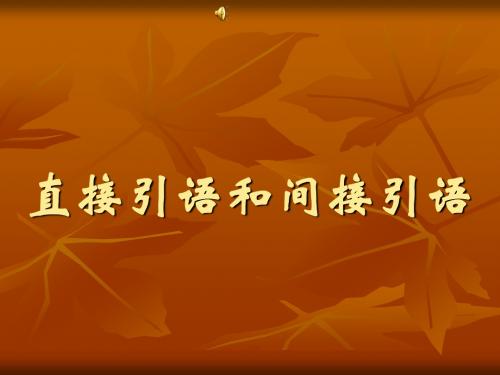
题例1 题例1
11. 12. 13. 14. 15. 16. 17. 18. 19. 20. 21. 22. 23. 24.
She said to me , “Will you go there with me ?” ?” She asked me, “Where is Xiao Li ?” ?” They asked the teacher, “Shall we have an English exam?” exam?” He asked me, “Which book do you like best?” best?” My aunt said to me, “Will you go for a walk with me? “Why didn’t you do it earlier?” he said. didn’ earlier?” “Who has taken my mirror?” Mary asked. mirror?” “Does everyone want to go ?” he said. ?” He said, “What size shoes does your father weat?” weat?” He said, “how many factories have built in your village?” village?” She said, “What are you doing here?” here?” My brother said, “I’ll never give up.” up.” The teacher said, “Can they speak English?” English?” She said, “Are you a League member?” member?”
直接引语和间接引语知识点总结

直接引语和间接引语知识点总结直接引语指的是直接引用他人的原话或言论,使用原文的具体表达和语气。
而间接引语则是通过自己的话来转述他人所说的内容。
在日常生活和学术写作中,我们经常会使用这两种引语形式来支持自己的观点和加强论证的力度。
以下是对直接引语和间接引语的知识点进行总结和归纳:1. 用引号标记直接引语在引用他人的原话时,直接将其放入引号中。
引号的使用方式有时根据语言习惯而有所不同。
例如,在英语中,使用双引号("")标记直接引语,而在中文中,则多使用单引号('')或直接将引语括起来。
例如:直接引语(英语):He said, "I am going to the park."直接引语(中文):他说:“我要去公园。
”2. 引用位置和标点符号引用的位置和标点符号的使用是关键。
在引用长句或段落时,通常将引号放在开头,句末的标点符号也放在引号内部。
而对于短句或片段,引号则放在句尾。
例如:长句引用:The author writes, "The success of a project depends on proper planning and execution."; (句末的分号放在引号内)短句引用:He simply said, "I agree."; (引号放在句尾)3. 引文中的引文在引用中存在引文的情况下,可以使用单引号作为引用内的标记。
例如:原句:He said, "I remember her exact words were, 'I will be there for you.'"直接引语:He said, "I remember her exact words were, 'I will be there for you.'"4. 间接引语的转述技巧间接引语并不直接使用原文的措辞,而是使用自己的话进行转述。
西班牙语基础语法学习:直接宾语和间接宾语

西班牙语基础语法学习:直接宾语和间接宾语
什么是西班牙语直接宾语,什么是间接宾语呢?下面看一些例句。
Quiero comprar un abrigo a mi mama. 我想给我妈妈买一件大衣。
这个地方的“买”后面跟的宾语是un abrigo.买这个动词的直接作用对象是一件大衣,所以它就是直接宾语,可是买大衣是给谁呢?a mi mama,虽然mi mama这里不是comprar
的直接作用对象,但是她是一个间接受力对象,所以它就是间接宾语。
教给大家一个小窍门,一般情况下,直接宾语会直接跟在动词后面,而间接宾语前面会有一个a. 下面monita酱再给大家几个例句,你们感受感受:
Podria pasar el libro a mi?你能把书递给我吗?
Quiero llevar unos juguetes a los chicos.我想给孩子们带一些玩具去。
千奕西班牙语小品词se用法
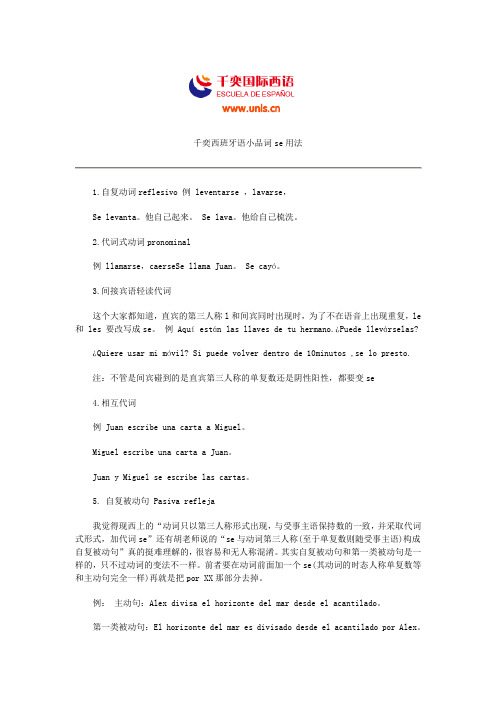
千奕西班牙语小品词se用法1.自复动词reflesivo 例 leventarse ,lavarse,Se levanta。
他自己起来。
Se lava。
他给自己梳洗。
2.代词式动词pronominal例 llamarse,caerseSe llama Juan。
Se cayó。
3.间接宾语轻读代词这个大家都知道,直宾的第三人称l和间宾同时出现时,为了不在语音上出现重复,le 和 les 要改写成se。
例Aquí están las llaves de tu hermano.¿Puede llevárselas?¿Quiere usar mi móvil? Si puede volver dentro de 10minutos ,se lo presto.注:不管是间宾碰到的是直宾第三人称的单复数还是阴性阳性,都要变se4.相互代词例 Juan escribe una carta a Miguel。
Miguel escribe una carta a Juan。
Juan y Miguel se escribe las cartas。
5. 自复被动句 Pasiva refleja我觉得现西上的“动词只以第三人称形式出现,与受事主语保持数的一致,并采取代词式形式,加代词se”还有胡老师说的“se与动词第三人称(至于单复数则随受事主语)构成自复被动句”真的挺难理解的,很容易和无人称混淆。
其实自复被动句和第一类被动句是一样的,只不过动词的变法不一样。
前者要在动词前面加一个se(其动词的时态人称单复数等和主动句完全一样)再就是把por XX那部分去掉。
例:主动句:Alex divisa el horizonte del mar desde el acantilado。
第一类被动句:El horizonte del mar es divisado desde el acantilado por Alex。
直接引语和间接引语用法讲解

直接引语和间接引语用法讲解之杨若古兰创作一、概述援用或转述他人说的话时有两种方法:直接引述他人的原话,这叫做直接引语(direct speech).用本人的话转述他人的话,叫间接引语(indirect speech).普通地讲,直接引语前后要加引号,间接引语不必引号,而用宾语从句来表达.Mr. Black said, “I'm busy.”布菜克师长教师说:“我很忙”.(直接引语)Mr. Black said that he was busy.布菜克师长教师说他很忙.(宾语从句是间接引语)从上例看来,直接引语改为间接引语时,除将直接引语改为宾语从句以外,还须对直接引语中的人称和时态进行响应的变更,如上例直接引语中的I改成了he, am则改成了was.现将由直接引语改为间接引语时应留意的成绩,分述如下:二、直接引语是陈述句时直接引语如果是陈述句,变成间接引语时,用连词that引诱(that在口语中常省去),that从句之前用say、tell等动词,从句中的人称、时态、唆使代词、时间状语、地点状语等要作响应的变更.1、人称的变更直接引语改为间接引语人称要响应的变更,把直接引语中的第一人称(如:I,me,my,mine,we,us,our,ours)变成与主句的主语相分歧的人称.把直接引语中的第二人称(you,your,yours)变成和主句的间接宾语(即听话人,如无听话人,可根据上下文的体会人为确定一个人称)相分歧的人称.直接引语中的第三人称(he,him,his,she,her,hers,it,its,they,their,theirs,them)变成间接引语时,人称不变.He said , “I like it very much.” 他说:“我非常爱好它”.→He said that he liked it very much. 他说他非常爱好它.(I改为he, it不变)He said, “You told me this story.”他说:“你给我讲过这个故事.”→He said that I had told him that story.他说我给他讲过那个故事.(You改为I, me改为him, told改为had told)He said to me, “She’s left her book in your room”.他对我说:“她把书放在你的房间里去了.”He told me that she had left her book in my room. 他对我说她把书放在我的房间里去了.(She’s→she had,her不变,your→my)2、时态的变更(1)主句的谓语动词是普通过去时如主句的谓语动词是普通过去时,直接引语变间接引语时,He said, “I had finished my homework before supper.”他说:“晚餐前我己做完了功课.”→He said that he had finished his homework before supper.他说晚餐前他己做完了功课.Zhou Lan said, “I'll do it after class.”周兰说:“下课后我就去做.”→Zhou Lan said that she would do it after class.周兰说下课后她就去做.He said,“I shall be doing my homework then.”他说:“那时我将正在做功课.”→He said that he should be doing his homework then.他说那时他将正在做功课.He said, “We shall have finished the work by that time.”他说:“我们将在那时之前完成工作.”→He said that they should have finished the work by that time.他说他们将在那时之前完成工作.留意:直接引语如果是客观真谛、名人名言、与一个具体的过去时间连用说明客观事实时,变成间接引语时,时态不变.The teacher said, “The earth is round. ”老师说:“地球是圆的.”→The teacher said that the earth is round.老师说地球是圆的.He said, “I was born in Shangdong in 1965.”他说: “我1965年生于山东.”→He said that he was born in Shangdong in 1965. 他说他1965年生于山东.He said, “Columbus discovered America in 1492.”他说:“哥伦布在1492年发现了美洲.”→He said Columbus discovered America in 1492.他说哥伦布在1492年发现了美洲.(2)主句的谓语动词是此刻时或将来时如果主句的谓语动词是此刻时或将来时,直接引语变成间接引语时,时态一概不变He says, “I finished the work.”他说:“我做竣工作了.”He says that he finished the work. 他说他做竣工作了.He will say, “I have watered the flowers.”他会说:“我己经浇花了.”He will say he has watered the flowers. 他会说他己经浇花了.3、唆使代词、时间状语和地点状语的响应变更见下表:He said, “I met Mr. Smith this morning.”他说“我今天凌晨见到史密斯了.”He said that he had met Mr. Smith that morning. 他说他那天凌晨见到史密斯了.He said, “We went to the cinema yesterday.” 他说:“我们昨天去电影院了.”→He said they had gone to the cinema the day before. 他说前一天他们去电影院了.Lily said, “I will come back next month.” 莉莉说:“我下个月回来.”→Lily said tha t she would go back the next month. 莉莉说她下一个月就回去.He said, “It is nine o'clock now.”他说:“此刻九点了.”→He said that it was nine o'clock then.他说那时九点了.He said, “I haven't seen her today.”他说:“今天我没见到她.”→He said that he hadn't seen her that day .他说那天他没有见到她.She said, “I went there yesterday.”她说:“昨天我去了那儿.”→She said that she had gone there the day before.她说前一天她去了那儿.She said, “I'll go there tomorrow.”她说:“明天我将去那儿.”→She said that she would go there the next day.她说第二天她将去那儿.He said, “My sister was here three days ago.”他说:“三天前我妹妹在这儿.”→He said that his sister had been there three days before.他说三天前他妹妹在那儿.(here→there; ago→before)She said, “I will come here this evening.”她说:“今晚我将来这儿.”→She said that she would go there that evening.她说那晚她将去那儿.(come→go;here→there;this→that)以上这些变更,要根据说话的具体时间和具体地点的情况而定,不成机械照搬.如果就在当地转述,here就不必改为there, come 也不必改为go,如果就在当天转述,yesterday或tomorrow等时间状语也不必改变.直接引语中的普通过去时如与一个具体的过去时间状语连用,间接引语的普通过去时时态不变.Father said,“I am free this afternoon ”父亲说:“我今天下战书有空.”→Father said that he was free this afternoon. 父亲说他今天下战书有空.He said, “I am going there tomorrow.”他说“我明天去那里.”He said that he was going there tomorrow. 他说他明天去那里.巧记:去掉引号加that,人称变更要灵活,时态向后退一步,状语变更按规定.三、直接引语是疑问句时直接引语如为疑问句,改为间接引语时,须将疑问句的语序改为陈述句的语序.其人称、时态等响应的变更同上.巧记:if(或whether)替引号,陈述语序要记牢.时态、人称和状语要变更,千万别把它忘掉.1、直接引语是普通问句变成间接引语时,须用连接词whether或if将其引出,使其成为间接引语的宾语从句.如果主句中的谓语动词为said,则将其改为asked.如果谓语动词后没有间接宾语,可以加上一个间接宾语me, him, her, them, us等.She said, “Is your father an engineer?”她说:“你父亲是工程师吗?”→She asked me whether my father was an engineer.她问我说我父亲是否是工程师.The teacher said to Li Ming, “Have you finished your homework?”老师对李明说:“你做完功课了吗?”→The teacher asked Li Ming whether he had finished his homework.老师问李明是否已做完功课了.2、直接引语是特殊问句如果直接引语为特殊疑问句, 改为间接引语时,仍用特殊疑问句中的疑问词what, where, when, who, how many作为连接词将其引出,构成间接引语中的宾语从句,但须将疑问式的动词改为陈述式.如果主句中的谓语动词为said,则将其改为asked.巧记:直接去引号,陈述语序莫忘掉.助动do(does)、did,要去掉.“What do you do every Sunday morning?”my friend said to me.我的朋友问我说,每礼拜天上午你做什么?→My friend asked me what I did every Sunday morning. 我的朋友问我每礼拜天上午我做什么.“Where have you been, Li Ming?”the teacher asked. 老师问道:“你上哪里去了,李明?”→The teacher asked Li Ming where he had been. 老师问李明曾去过哪儿.I asked her, “How many English books will you read next term?” 我问她说:“下学期你将读多少本英语书? ”→I asked her how many English books she would read the next term.我问她下学期将读多少本英文书.“When did you get up this morning?”asked my father.我父亲问道:“今天凌晨你什么时候起床的?”→My father asked me when I had got up that morning. 我父亲问我那天凌晨我是什么时候起床的.留意:直接引语里是:What's wrong with……?/What's the matter? /What's the trouble?/What has happened?/等特殊疑问句时,间接引语的语序不变.He said to her“What’s the matter with you?”他问她“你怎样了?”He asked her what was the matter with her. 他问她怎样了.四、直接引语是祈使句巧记:去掉引号要加to;ask,order须记住,直引若是否定式,not加在to前部.转述祈使句时,要使祈使句的动词本相变成带to的不定式,并在不定式的前面根据句子的意思加上tell、ask、order等动词,如果祈使句为否定式,在不定式的前面加not.如果祈使句中有please一词,改为间接引语时,就将please去掉.成为:told (asked, ordered, warned)someone (not)to do something结构.He said,“Sit down, please.” 他说:“请坐.”→He asked me to sit down. 他让我坐下.The teacher said, “Don’t talk in class! ” 老师说:“上课不要讲话! ”→The teacher told us not to talk in class!老师要我们上课不要讲话.The captain said to his men,“Fire! ”上尉对他的士兵们说“开火!”→The captain ordered his men to fire. 上尉命令他的士兵们开火!The policeman said to the children,“Don't play football in the middle of the street.”警察对孩子们说:“别在马路两头踢足球.”→The policeman warned the children not to play football in the middle of the street.警察警告孩子们不要在马路两头踢足球.五、点击考点I.改错:1.He said that he is going to London.2.Tom said they had finished the job yesterday.3.She asked me don’t smoke in the room.4.They asked that he was there.5.I asked you where was he going.6.The teacher told us not talk any more.7.The doctor said to his wife, Not wait for me.8.He asked me who I am.9.Mary said that she would see you tomorrow.10.Mother asked what the matter was.1. “Where will you go tomorrow?”, Mother asked me.2.The old woman said to me, “Please lock the door for me.”3.The boy told his teacher, “We went to an exhibition yesterday.”4.He said, “I'll go to the station to see off a friend of mine this afternoon.”5. “Hello,how are you?”, he said t o me.6.Tom said to me angrily, “Why don’t you tell me you have been here for two weeks?”7.John said to Mary,“Do you remember I borrowed a diamond necklace from you?”8.The teacher said to Li Ming,“Don’t make the same mistake again.”9. “Are you leaving today or tomorrow?”, I asked her.10.The nurse said to the children, “The sun rises in the east.”参考答案:I. 1.is→was 2.yesterday→the day before3.don’t→notto 4.that→if5.was he→he was6.not 后面加to7.Not→Don't8.am→was9.tomorrow→the next day 10.was the matterII. 1.Mother asked me where I would go the next day.2.The old woman asked me to lock the door for her.3.The boy told his teacher that they had gone to an exhibition the day before.4.He said that he would go to the station to see off a friend of his that afternoon.5.He asked me how I was.6.Tom asked me angrily why I didn't tell him I had been there for two weeks.7.John asked Mary if she remembered he had borrowed a diamond necklace from her.8.The teacher told Li Ming not to make the same mistake again.9.I asked her whether she was leaving that day or the next day.10.The nurse told the children that the sun rises in the east.。
直接引语和间接引语语法

He told the boys not to make so much noise.
注意:(1)直接引语如果是客观真理,变 为间接引语时,时态不变。如:
He asked Richard to help him with his homework.
“Shall I bring you some tea?” he asked me.
He offered to bring me some tea.
3祈使句(Imperatives)
转述祈使句时,要将祈使句的动词原形变为带 to的不定式,并在不定式的前面根据句子的意 思加上tell, ask, order等动词,如果祈使句为 否定式,在不定式的前面加not。即: tell/ask/order sb.(not) to do sth.例如:
Mr Black said that he was busy. 布莱克先生说他很忙。(间接引语)
1 陈述句(Statements)
直接引语如果是陈述句,变为间接引 语时,用连词that 引导(that 在口语中 常省略),从句中的人称、时态、指示代 词、时间状语、地点状语等要作响应的变 化。在这一方面,汉语和英语有许多相似 之处,因此在做直接引语和间接引语转换 练习时,要特别注意句子的意义。
特殊疑问句:直接引语如果是特殊疑问句, 变为间接引语时,仍用原来的疑问词引导。 并且变疑问语序为陈述语 序,改问号为句 号。引述的动词常用ask, want to know, wonder 等。如:
“What can I do for you?” he asked me
直接引语与间接引语

直接引语与间接引语直接引语:一字不改的引用或复述别人的话,被引用或复述的部分即为直接引语。
一般前后用引号,首字母大写。
通常放于句首或句尾。
间接引语:用自己的话转述别人的话,被转述的部分即为间接引语。
通常以宾语从句的形式出现,不用引号。
直接引语变为间接引语时的时态变化如果主句是过去式态,变为间接引语时的一般规律一般现在时---一般过去式,现在进行时---过去进行时,现在完成时---过去完成时,一般过去时---过去完成时,过去进行时---过去完成进行时,一般将来时---过去将来时,现在完成进行时----过去完成进行时,过去完成时---过去完成时等。
时态不需要变化的情况1、当直接引语表示的是客观真理或经常性的特点时。
例如 She said,"The earth goes around the sun".--She said that the earth goes around the sun.2、当直接引语中有绝对具体的过去时间作状语时,保持原来的一般过去时。
例如 He said,"I left home in 1942.—He said he left home in 1942.3、当强调动作或状态现在仍然如此时,可保持原时态She said ,”I will be back tonight.”----She said she will be back tonight .4、当直接引语是虚拟语气时,保持原时态。
He said ,”I wish I could fly .”—He said he wished he could fly.二、直接引语变为间接引语时连词的选择1、陈述句陈述句转化为间接引语时用that引导,也可省略 that。
主句动词主要为say,tell,reply,explain,think,repeat等。
例如Danny said,"I come from Canada."—Danny said that he came from Canada.疑问句直接引语是疑问句变为间接引语时要用陈述语序。
- 1、下载文档前请自行甄别文档内容的完整性,平台不提供额外的编辑、内容补充、找答案等附加服务。
- 2、"仅部分预览"的文档,不可在线预览部分如存在完整性等问题,可反馈申请退款(可完整预览的文档不适用该条件!)。
- 3、如文档侵犯您的权益,请联系客服反馈,我们会尽快为您处理(人工客服工作时间:9:00-18:30)。
千奕西班牙语入门语法:直接引语和间接引语
一、引用别人的原话叫直接引语(estilo directo)例:
El maestro ha dicho: Estad quietos y atended.(老师说:“安静,注意听。
”)
En este caso , dijo Tom, no podremos entendernos.(“这样”,汤姆说,“我们就无法相互理解了。
”)
二、转述别人的话叫间接引语(estilo indirecto),如把上面两句变成间接引语,就如下:
El maestro ha dicho que estuviésemos quietos y atendiésemos.
Tom dijo que en este caso no podrímos entendernos.
直接引语变为间接引语,除了在引语的前面加连词que之外,还应注意动词人称和时态的变化。
如果直接引语是疑问句,除动词的人称、时态要注意和主句动词保持一致外,一般疑问句要在副句前面加连接词si,部分疑问句一般不加连接词。
如:
“¿Has terminado el trabajo?”
El pregunta si he terminado el trabajo.
如果直接引语是祈使句,简介引语的动词用虚拟式。
如;
El dice:“No corras tanto.”
El dice que no corra tanto.
El dijo:“Trabaje usted.”
El dijo que trabajara yo.。
